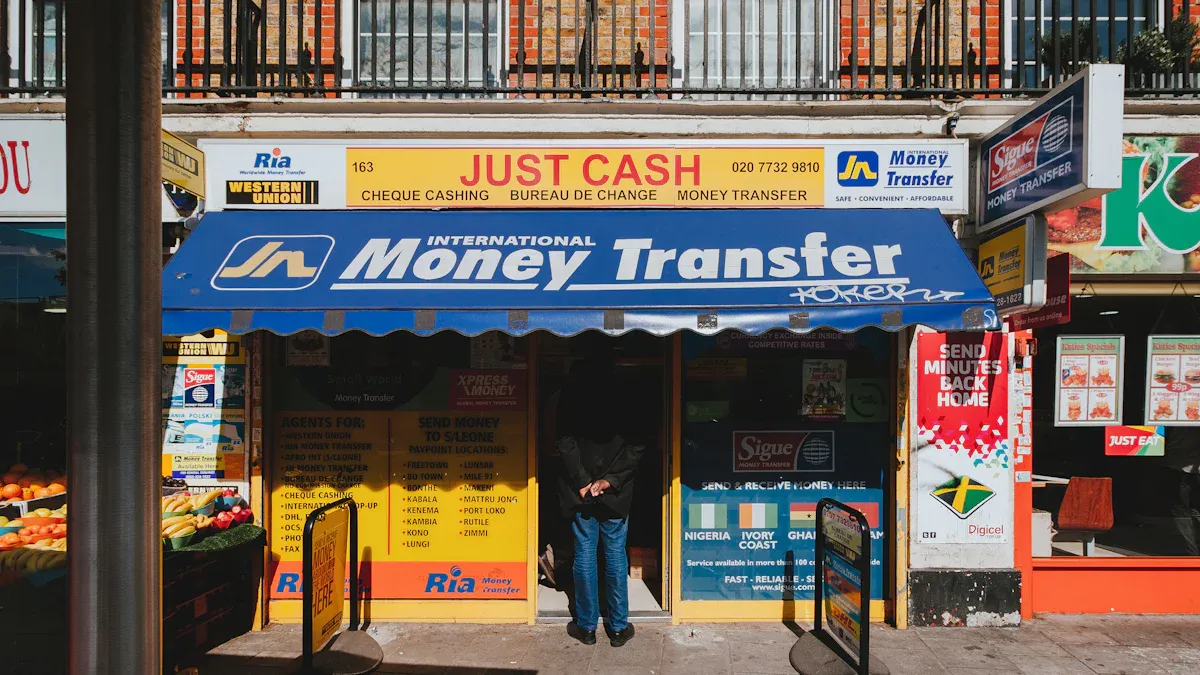- EasyCard
- Trade
- Help
- Announcement
- Academy
- SWIFT Code
- Iban Number
- Referral
- Customer Service
- Blog
- Creator
How to Understand the Exchange Rate of the Colombian Peso and Remittance Skills to Ensure the Security and Maximum Value of Funds

Image Source: pexels
Every year, substantial funds cross borders, flowing to families and businesses in Colombia.
- According to Statista’s research report, the amount of personal remittances to Colombia consistently remains in the billions of dollars.
When making cross-border transfers, your core goal is clear: ensure the safety of your funds and secure the best Colombian Peso exchange rate. By mastering the right methods, you can not only save on actual costs but also ensure every remittance is secure and worry-free, maximizing the value of your funds.
Key Takeaways
- Understanding exchange rates is crucial. Before remitting, you should check the mid-market exchange rate and compare the buy and sell rates offered by different providers.
- Choose the right remittance method. You can opt for traditional banks, online platforms, or cash remittance services, depending on the remittance amount, urgency, and whether the recipient has a bank account.
- Online platforms are more cost-effective for remittances. Platforms like Wise and Remitly are typically cheaper than banks and offer faster delivery.
- Protect your funds’ safety. You should carefully verify recipient information and understand remittance limits and relevant regulations.
- Utilize exchange rate locking features. Some platforms offer rate-locking services to help you avoid losses due to exchange rate fluctuations.
Understanding Colombian Peso Exchange Rates in Depth

Image Source: unsplash
The first step in remitting is mastering exchange rate information. A seemingly small exchange rate difference can have a significant impact on larger remittance amounts. Therefore, you need to understand the basics of exchange rates and how to check them.
Exchange Rate Basics and Currency Symbols
When you check exchange rates, you typically see three different prices:
- Mid-market Exchange Rate: This is the midpoint between the buy and sell rates. It represents the fairest value of a currency without any hidden fees and serves as your benchmark for assessing remittance costs.
- Buy Rate: This is the price at which a remittance provider is willing to buy a currency (e.g., USD) from you.
- Sell Rate: This is the price at which a provider sells another currency (e.g., Colombian Peso) to you.
Practical Tip: The exchange rate you actually receive is typically the “sell rate.” The smaller the gap between this rate and the “mid-market rate,” the more cost-effective your transaction will be.
Additionally, recognizing the currency symbols for the Colombian Peso is crucial. You may encounter the following notations on different platforms:
- $: This is the official symbol, but it can be confused with the US dollar.
- COP: This is the International Organization for Standardization (ISO) currency code, widely used in foreign exchange markets.
- COL$: This unofficial abbreviation is often used for clarity to distinguish it from other currencies.
Reliable Channels for Checking Exchange Rates
You can access real-time Colombian Peso exchange rates through several authoritative channels. Below is a comparison of commonly used tools:
| Tool | Advantages | Disadvantages |
|---|---|---|
| Google Finance | Simple interface, provides real-time exchange rates, supports multiple currency conversions, ideal for quick checks. | Does not provide historical data, may have slight delays, unsuitable for real-time trading decisions. |
| XE.com | Offers competitive rates, supports most global currencies, user-friendly platform, provides real-time tracking. | Exchange rate margins may not be the lowest, account verification process can be cumbersome. |
| Reuters | Provides professional market analysis and data, comprehensive coverage, trusted by financial institutions. | Content is geared toward professional traders, may be overly complex for regular users, some services are costly. |
Timing Your Remittance for Optimal Rates
The Colombian Peso exchange rate is highly volatile. Seizing favorable timing for remittances can maximize the value of your funds. Monitoring the USD to Colombian Peso (USD/COP) exchange rate trend is key.
As shown, the exchange rate can fluctuate significantly in the short term. For example, over the past 90 days, the rate has varied between 3,830 and 4,198. These fluctuations are primarily influenced by the following factors:
- External Factors: The Federal Reserve’s interest rate policies directly affect the strength of the USD, thereby altering the exchange rate.
- Internal Factors: Colombia’s economic policies, fiscal conditions, and investor confidence also significantly impact the value of the Peso.
Therefore, spending a few minutes before remitting to review exchange rate trends and determine whether the rate is high or low can help you make more informed decisions.
Comparing and Choosing the Best Remittance Channels

Image Source: unsplash
After understanding exchange rates, the next step is selecting the remittance channel that best suits your needs. Different channels vary significantly in fees, speed, and convenience. Choosing correctly can save you considerable costs.
Analysis of Traditional Bank Wire Transfers
International wire transfers through banks are the most traditional method. You can typically process them at a bank branch or via online banking.
- Advantages: High security, suitable for large transactions, standardized process.
- Disadvantages: High fees, slow delivery (typically 1–5 business days), and non-transparent exchange rates.
Bank remittance costs consist of two parts: explicit fees and hidden exchange rate margins. For example, a major US bank’s fee structure is as follows:
- Online Foreign Currency Transfer: A $5 fee for amounts below 5,000 USD; no fee for amounts equal to or exceeding 5,000 USD.
- In-Person Transfer: Fees can be as high as $50.
Important Note: Banks typically set their own exchange rates, which include a profit “spread.” This means the rate you receive will be less favorable than the mid-market rate seen on Google or Reuters. This hidden cost can far exceed the explicit fees.
Comparison of Online Remittance Platforms
In recent years, online remittance platforms have gained popularity due to their low fees, high transparency, and convenience. Below is a comparison of several mainstream platforms:
| Platform | Exchange Rate Features | Fees | Delivery Speed | Suitable Scenarios |
|---|---|---|---|---|
| Wise | Uses mid-market exchange rate, no markup. | Transparent, proportional fees (starting from 0.57%). | Fast, most remittances completed in minutes to hours. | Users who prioritize rate and fee transparency. |
| Remitly | Offers promotional rates for new users, but regular rates include a markup. | Tiered fees based on amount and speed. | Offers “Economy” (slower) and “Express” (faster) options. | Users needing multiple delivery methods (e.g., cash pickup). |
| WorldRemit | Offers discounted rates for first-time transfers. | Fixed fees depending on delivery method. | Relatively fast, supports credit/debit card payments for speed. | First-time remitters seeking flexible delivery options. |
Wise’s core advantage lies in its transparency. It consistently offers the true mid-market exchange rate, and you can see all fees upfront with no surprises. For example, sending 1,000 USD incurs fees of approximately 28.26 USD, with the recipient receiving Pesos based on the true exchange rate.
Remitly offers flexible speed options. You can choose a lower-cost but slower “Economy” transfer or a higher-cost but faster “Express” transfer. Note, however, that Remitly’s rates include a 0.5% to 3.0% markup, which is a hidden cost.
Analysis of Cash Remittance Services
If your recipient in Colombia lacks a bank account or prefers cash, cash remittance services are the best option.
According to the Bank of the Republic of Colombia, in 2024, 77.8% of daily transactions in Colombia were still completed in cash.
This indicates that cash remains critical in local life. For example, Western Union has an extensive global network of agents, allowing recipients to conveniently pick up cash at nearby locations with identification and a transaction code.
- Advantages: No bank account required for recipients, widespread agent network, convenient and fast cash pickup.
- Disadvantages: Relatively high fees, especially for small remittances. The Colombian Peso exchange rate often includes a significant profit margin.
Western Union’s fees vary based on the remittance amount, payment method, and destination. You can use their price estimator tool to understand the total cost in advance.
Decision Checklist for Channel Selection
Faced with numerous options, you can quickly find the most suitable channel by answering these three questions:
- How urgent is your remittance?
- Very Urgent: Choose Remitly’s “Express” service, WorldRemit, or Wise. These platforms typically complete transfers in minutes or hours.
- Not Urgent: Opt for Remitly’s “Economy” service or Wise. You can trade speed for lower fees. Bank wire transfers are typically the slowest.
- What is your remittance amount?
- Small Remittances (below 500 USD): Online platforms (e.g., Wise, Remitly) are far more cost-effective than bank wire transfers, as banks’ fixed fees take up a higher proportion.
- Large Remittances (above 5,000 USD): Wise remains competitive. Some banks may waive fees, but you must carefully compare the hidden costs from exchange rate spreads.
- Does the recipient have a bank account?
- Has a Bank Account: All channels are viable. You can prioritize Wise or Remitly to deposit funds directly into the recipient’s bank account.
- No Bank Account: Choose services supporting cash pickup, such as Western Union, Remitly, or WorldRemit. Recipients can collect cash at partner locations like Bancolombia, Éxito. Additionally, some platforms support direct transfers to Colombia’s local mobile wallets like Nequi.
By using this simple decision checklist, you can find the optimal balance between speed, cost, and convenience based on your specific needs.
Practical Tips for Fund Safety and Value Maximization
After selecting the right channel, you also need to master practical tips. These techniques will help you mitigate risks in the final stages of remittance, ensuring every penny arrives safely and maximizes its value.
Tip 1: Lock Exchange Rates to Avoid Fluctuations
The volatility of the Colombian Peso exchange rate means that from the time you initiate a remittance to when the funds arrive, the rate may have changed. To avoid losses due to this uncertainty, you can utilize the “lock exchange rate” feature.
Many online remittance platforms (e.g., Wise) offer exchange rate guarantee services. This means the platform locks in a specific rate for you, typically valid for 24 to 72 hours.
Key Actions:
- Automatic Locking: When you create a transfer, some services automatically provide a guaranteed rate and validity period.
- Timely Payment: You must complete the payment within the guarantee period for the platform to process the exchange at the locked rate.
- Note Exceptions: If funds arrive after the guarantee period, the platform will use the real-time exchange rate. Additionally, if the relevant rate fluctuates by more than 5% during the guarantee period, the provider reserves the right to cancel the transaction.
This feature acts like “exchange rate insurance” for your remittance, allowing you to know exactly how much the recipient will receive when initiating the transfer.
Tip 2: Identify All Hidden Fees
The total cost of a remittance is not just the visible fees. Many additional costs are hidden in the transaction process, quietly eroding your funds.
Hidden fees primarily come from two sources:
- Exchange Rate Markup: This is the most common hidden fee. Providers often add a profit margin to the mid-market exchange rate. While this spread may seem small, it can accumulate into significant costs for large remittances.
- Intermediary Bank Fees: When your funds are transferred through international banking networks (e.g., SWIFT), they may pass through one or more intermediary banks. These banks charge fees for processing your transfer, typically between $15 and $30. Since these fees are hard to predict at the time of initiation, they often become an unexpected expense.
Practical Formula: To see the full cost, you can use this simple formula:
Total Cost = Explicit Fees + (Mid-market Rate - Actual Rate) × Remittance Amount + Other Bank FeesSpending a minute to calculate before remitting can help you clearly compare the true costs of different channels.
Tip 3: Verify Recipient’s Key Information
A single input error can lead to remittance delays, failures, or even losses. Therefore, double-checking recipient information before clicking “send” is critical.
The most common errors include:
- Incorrect spelling of the recipient’s name.
- Incorrect bank account or mobile wallet number.
- Incorrect bank name or SWIFT/BIC code.
Colombian banks and mobile wallets have different requirements for recipient information. Ensure you provide accurate details based on the specific service used by the recipient.
| Bank/Mobile Wallet | Recipient Information/Action Requirements |
|---|---|
| Banco de Bogotá | As long as the account information is correct, funds will be deposited automatically, requiring no additional action from the recipient. |
| Nequi Mobile Wallet | For first-time recipients, the recipient must confirm their subscription in the Nequi app to receive international remittances. |
| DAVIPlata Mobile Wallet | First-time recipients of international remittances must personally visit a Davivienda bank branch to collect the initial funds. |
| Other Banks | Some banks may require recipients to register online and upload identification documents to receive funds. |
Safety Tip: Always communicate directly with your recipient to confirm they have completed all necessary preparations for receiving international remittances. This can effectively avoid delays due to recipient issues.
Tip 4: Understand Remittance Limits and Regulations
To combat money laundering and other illegal activities, all international remittances are subject to strict financial regulations. Understanding these rules can help your remittance pass compliance reviews smoothly.
According to Colombia’s Financial Information and Analysis Unit (UIAF), remittance providers must report transactions of specific amounts to the authorities. For example:
- Single transactions exceeding $150 must be reported.
- Monthly cumulative transactions exceeding $450 must also be reported.
Note: These are “reporting” requirements, not remittance “limits.” As long as your funds come from legitimate sources, normal remittances will not be affected.
For large remittances, you may need to provide additional documents to prove the legitimacy of the funds’ source. This is part of the standard “Know Your Customer” (KYC) process.
| Transfer Purpose | Possible Required Documents |
|---|---|
| Property Sale | Final sales contract, bank statement showing receipt, title deed registration documents. |
| Salary Income | Recent pay stubs, employer letter, tax return. |
| Inheritance | Copy of the will, relevant court documents, bank statement showing receipt. |
| Loan Repayment | Loan agreement, recent loan statement. |
Preparing these documents in advance can ensure your large remittances are completed quickly and smoothly.
Now, you have mastered the core strategies for secure and efficient remittances to Colombia. To ensure your funds’ safety and maximize their value, remember these three key steps:
- Compare Multiple Providers: Before transferring, use authoritative tools to compare exchange rates and fees across platforms.
- Choose the Best Channel: Based on your remittance amount and urgency, select the most suitable option among banks, Wise, or Remitly.
- Apply Practical Tips: Mitigate potential risks by locking exchange rates and carefully verifying recipient information.
Before each remittance, spend a few minutes comparing and verifying. This is the most responsible approach to your funds and the best practice for ensuring every penny maximizes its value.
FAQ
Which remittance method is the fastest?
Online platforms like Wise or Remitly’s “Express” service are typically the fastest, with funds arriving in minutes. You need to use a debit or credit card for payment to ensure speed. Traditional bank wire transfers are the slowest.
How do I find the cheapest remittance channel?
You should always compare the total cost, not just the fees. Wise is often the most cost-effective due to its transparent mid-market exchange rate. Use their calculator to see the final amount, including all fees.
Is it safe to use online platforms for remittances?
Yes, reputable platforms (e.g., Wise, Remitly) are regulated by financial authorities just like banks. They use encryption to protect your data and funds. Choose providers regulated by official authorities.
What should I do if the recipient doesn’t receive the money?
- First, verify that the recipient information you provided is completely accurate.
- Then, contact the customer service of the remittance provider you used, providing the transaction reference number for inquiry.
*This article is provided for general information purposes and does not constitute legal, tax or other professional advice from BiyaPay or its subsidiaries and its affiliates, and it is not intended as a substitute for obtaining advice from a financial advisor or any other professional.
We make no representations, warranties or warranties, express or implied, as to the accuracy, completeness or timeliness of the contents of this publication.




Contact Us
Company and Team
BiyaPay Products
Customer Services
is a broker-dealer registered with the U.S. Securities and Exchange Commission (SEC) (No.: 802-127417), member of the Financial Industry Regulatory Authority (FINRA) (CRD: 325027), member of the Securities Investor Protection Corporation (SIPC), and regulated by FINRA and SEC.
registered with the US Financial Crimes Enforcement Network (FinCEN), as a Money Services Business (MSB), registration number: 31000218637349, and regulated by FinCEN.
registered as Financial Service Provider (FSP number: FSP1007221) in New Zealand, and is a member of the Financial Dispute Resolution Scheme, a New Zealand independent dispute resolution service provider.



















